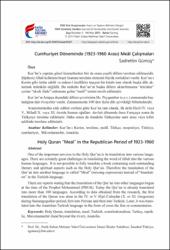| dc.contributor.author | Gümüş, Sadrettin | |
| dc.date.accessioned | 2015-07-02T13:19:33Z | |
| dc.date.available | 2015-07-02T13:19:33Z | |
| dc.date.issued | 2015-07 | |
| dc.identifier.citation | GÜMÜŞ, Sadrettin. "Cumhuriyet Döneminde (1923-1960 Arası) Meâl Çalışmaları." FSM İlmî Araştırmalar İnsan ve Toplum Bilimleri Dergisi, 5 (2015): 285-332. | en_US |
| dc.identifier.uri | http://dergi.fsm.edu.tr/index.php/ia/article/view/675/684 | |
| dc.identifier.uri | https://hdl.handle.net/11352/2198 | |
| dc.description.abstract | Kur’ân’a yapılan güzel hizmetlerden biri de onun çeşitli dillere tercüme edilmesidir.
Şüphesiz Allah kelâmını beşer lisanına tercüme etmenin büyük zorlukları vardır. Kur’an-ı
Kerim gibi üstün edebî ve mânevî özellikler taşıyan bir kitabı tam olarak başka dile aktarmak
mümkün değildir. Bu nedenle Kur’an’ın başka dillere aktarılmasına “tercüme”
yerine “eksik ifade” anlamına gelen “meâl” terimi tercih edilmiştir.
Kur’an’ın Arapça dışındaki dillere çevirisinin Hz. Peygamber (s.a.v.) zamanında başladığına
dair rivayetler vardır. Zamanımızda 100’den fazla dile çevrildiği bilinmektedir.
Araştırmalardan elde edilen verilere göre Kur’an tam olarak, ilk defa Hicrî IV. veya
V., Miladî X. veya XI. Asırda Saman oğulları devleti dönemde önce Farsçaya sonra da
Türkçeye tercüme edilmiştir. Daha sonra da Anadolu Türkçesine satır arası veya tefsir
şeklinde tercüme edilmiştir. | en_US |
| dc.description.abstract | One of the important services to the Holy Qur’an is its translation into various languages.
There are certainly great challenges in translating the word of Allah into the various
human languages. It is not possible to fully translate a book containing such outstanding
literary and spiritual aspects such as the Holy Qur’an. Therefore the translation of the
Qur’an into another language is called “Meal” (missing expression) instead of “translation”
in the Turkish language.
There are reports stating that the translation of the Qur’an into other languages began
at the time of the Prophet Mohammad (PBUH). Today the Qur’an is already translated
into more than 100 languages. According to data obtained from the research, the first
translation of the Quran was done in the IV. or V. Hijri Calendar (X. or XI. Gregorian)
during Samangogulları period, first into Persian and then into Turkish. Later, it was translated
into the Anatolian Turkish language in the form of cross the line or commentaries. | en_US |
| dc.language.iso | tur | en_US |
| dc.publisher | FSM Vakıf Üniversitesi | en_US |
| dc.rights | info:eu-repo/semantics/openAccess | en_US |
| dc.subject | Kur’an-ı Kerim | en_US |
| dc.subject | Tercüme | en_US |
| dc.subject | Meal | en_US |
| dc.subject | Türkçe | en_US |
| dc.subject | Meşrutiyet | en_US |
| dc.subject | Türkiye | en_US |
| dc.subject | Cumhuriyet | en_US |
| dc.subject | Maveraunnehir | en_US |
| dc.subject | Anadolu | en_US |
| dc.subject | Holy Quran | en_US |
| dc.subject | Translation | en_US |
| dc.subject | Turkish | en_US |
| dc.subject | Constitutionalism | en_US |
| dc.subject | Turkey | en_US |
| dc.subject | Republic | en_US |
| dc.subject | Maveraunnehir (land beyond the river) | en_US |
| dc.subject | Anatolia | en_US |
| dc.title | Cumhuriyet Döneminde (1923-1960 Arası) Meal Çalışmaları | en_US |
| dc.title.alternative | Holy Quran “Meal” in the Republican Period of 1923-1960 | en_US |
| dc.type | article | en_US |
| dc.contributor.department | FSM Vakıf Üniversitesi, FSM İlmî Araştırmalar İnsan ve Toplum Bilimleri Dergisi | en_US |
| dc.relation.publicationcategory | Makale - Ulusal Hakemli Dergi - Kurum Öğretim Elemanı | en_US |



















